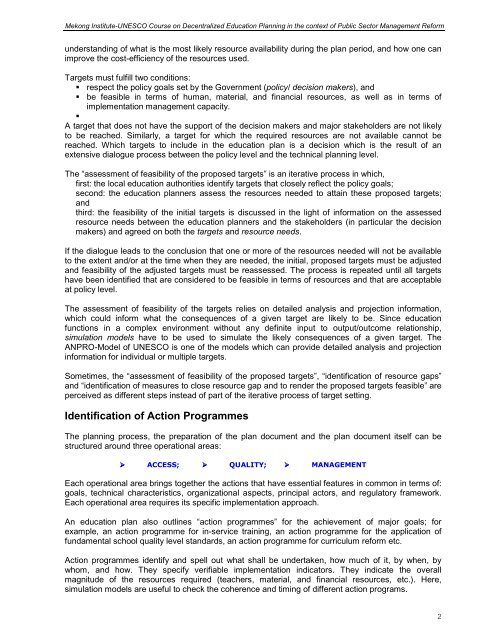Education Analysis and Projection Model - UNESCO Bangkok
Education Analysis and Projection Model - UNESCO Bangkok
Education Analysis and Projection Model - UNESCO Bangkok
You also want an ePaper? Increase the reach of your titles
YUMPU automatically turns print PDFs into web optimized ePapers that Google loves.
Mekong Institute-<strong>UNESCO</strong> Course on Decentralized <strong>Education</strong> Planning in the context of Public Sector Management Reformunderst<strong>and</strong>ing of what is the most likely resource availability during the plan period, <strong>and</strong> how one canimprove the cost-efficiency of the resources used.Targets must fulfill two conditions: respect the policy goals set by the Government (policy/ decision makers), <strong>and</strong> be feasible in terms of human, material, <strong>and</strong> financial resources, as well as in terms ofimplementation management capacity.A target that does not have the support of the decision makers <strong>and</strong> major stakeholders are not likelyto be reached. Similarly, a target for which the required resources are not available cannot bereached. Which targets to include in the education plan is a decision which is the result of anextensive dialogue process between the policy level <strong>and</strong> the technical planning level.The “assessment of feasibility of the proposed targets” is an iterative process in which,first: the local education authorities identify targets that closely reflect the policy goals;second: the education planners assess the resources needed to attain these proposed targets;<strong>and</strong>third: the feasibility of the initial targets is discussed in the light of information on the assessedresource needs between the education planners <strong>and</strong> the stakeholders (in particular the decisionmakers) <strong>and</strong> agreed on both the targets <strong>and</strong> resource needs.If the dialogue leads to the conclusion that one or more of the resources needed will not be availableto the extent <strong>and</strong>/or at the time when they are needed, the initial, proposed targets must be adjusted<strong>and</strong> feasibility of the adjusted targets must be reassessed. The process is repeated until all targetshave been identified that are considered to be feasible in terms of resources <strong>and</strong> that are acceptableat policy level.The assessment of feasibility of the targets relies on detailed analysis <strong>and</strong> projection information,which could inform what the consequences of a given target are likely to be. Since educationfunctions in a complex environment without any definite input to output/outcome relationship,simulation models have to be used to simulate the likely consequences of a given target. TheANPRO-<strong>Model</strong> of <strong>UNESCO</strong> is one of the models which can provide detailed analysis <strong>and</strong> projectioninformation for individual or multiple targets.Sometimes, the “assessment of feasibility of the proposed targets”, “identification of resource gaps”<strong>and</strong> “identification of measures to close resource gap <strong>and</strong> to render the proposed targets feasible” areperceived as different steps instead of part of the iterative process of target setting.Identification of Action ProgrammesThe planning process, the preparation of the plan document <strong>and</strong> the plan document itself can bestructured around three operational areas: ACCESS; QUALITY; MANAGEMENTEach operational area brings together the actions that have essential features in common in terms of:goals, technical characteristics, organizational aspects, principal actors, <strong>and</strong> regulatory framework.Each operational area requires its specific implementation approach.An education plan also outlines “action programmes” for the achievement of major goals; forexample, an action programme for in-service training, an action programme for the application offundamental school quality level st<strong>and</strong>ards, an action programme for curriculum reform etc.Action programmes identify <strong>and</strong> spell out what shall be undertaken, how much of it, by when, bywhom, <strong>and</strong> how. They specify verifiable implementation indicators. They indicate the overallmagnitude of the resources required (teachers, material, <strong>and</strong> financial resources, etc.). Here,simulation models are useful to check the coherence <strong>and</strong> timing of different action programs.2
















